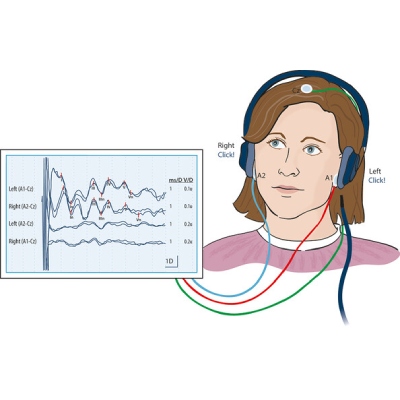SSEP Test
Get in Touch
A Full services from a SSEP Test
SSEP stands for “Somatosensory Evoked Potentials”, which are a type of neurophysiological test used to evaluate the functioning of the sensory pathways in the nervous system.
During an SSEP test, a small electrical stimulus is applied to a specific part of the body, typically the hands or feet, and the resulting electrical activity in the nerves is recorded by electrodes placed on the scalp or other parts of the body.
The recorded responses are then analyzed to determine if there are any abnormalities or disruptions in the sensory pathways. SSEP tests are often used to diagnose conditions such as spinal cord injuries, multiple sclerosis, and other neurological disorders.
When is the SSEP used?
If you’ve been experiencing weakness or numbness in your arms or legs that may be related to problems affecting the somatosensory nerve pathway, a doctor may suggest a SSEP test. These sensations are often subtle and not easily detected during a regular clinical examination.
What does the SSEP detect?
The SSEP test can determine the time it takes for nerve fibers to transmit a stimulus from the wrist or ankle to a detection site on the neck, scalp, or back. By analyzing the pattern of SSEP responses, a neurologist can assess the functionality of sensory nerves. For instance, demyelination, which is a process that involves damage to the myelin sheath that insulates nerve fibers in the brain and spinal cord, can occur in multiple sclerosis (MS). This damage may lead to a delay in the transmission of signals through nerve pathways, or they may be blocked, resulting in changes in the SSEP pattern.
How to prepare for a SSEP test
To prepare for an SSEP test, notify the person conducting the test if you have a pacemaker.
You can eat a regular meal before the procedure, but it’s important to bring a list of your medications.
Avoid taking sedatives or drugs that cause drowsiness.
Arrive on time and try to relax; no further preparation is necessary.
How the SSEP Test Works
- Preparation: The patient may be asked to remove any jewelry and wear a hospital gown. The technician will clean the skin areas where the electrodes will be placed to ensure good contact.
- Electrode Placement: Small electrodes are attached to the skin over the nerves being tested, as well as on the scalp and other relevant areas. These electrodes are connected to a machine that records the electrical signals.
- Stimulation: Mild electrical pulses are delivered to the nerves through the electrodes. These pulses may cause a tingling sensation but are generally painless. The intensity of the stimuli is adjusted to ensure clear and measurable responses.
- Recording: The electrical activity generated by the stimuli is recorded by the electrodes on the scalp and other areas. The signals are then analyzed to measure the time it takes for the impulses to travel from the point of stimulation to the brain.
- Analysis: The recorded signals are compared to normal values to identify any abnormalities in the sensory pathways. Delays or absent signals can indicate nerve damage, spinal cord injuries, or other neurological disorders.
What happens during a SSEP test?
During the SSEP test, you’ll need to remove your shoes and outer upper garments to allow for electrode placement.
Detection electrodes will be attached to specific spots on your scalp, neck, and back. A small generator will produce tiny electrical impulses to stimulate nerves in your wrist or ankle. While these impulses are usually not painful, they may cause slight twitching in your thumb or toe, which is normal.
To obtain accurate test results, it’s crucial to listen carefully to the person conducting the test, follow their instructions, and try to remain relaxed.
Special equipment will record your responses to the electrical stimulation through the electrodes.
After the procedure, the electrodes will be removed, and you can put your clothes and shoes back on. Unless instructed otherwise, you should be able to go straight home.
Your doctor or referring doctor will discuss the results of the SSEP test with you after analyzing them.
What is the accuracy of SSEP?
For each study, the specificities ranged from 86% to 99% and the sensitivities from 4% to 88%. Among all investigations, the sensitivity was 44% (95% CI, 22%-67%)
How long does an SSEP test take?
What is the alert criteria for SSEP?
What are the side effects of SSEP?
CONTACT US
Give Us Your Feedback


